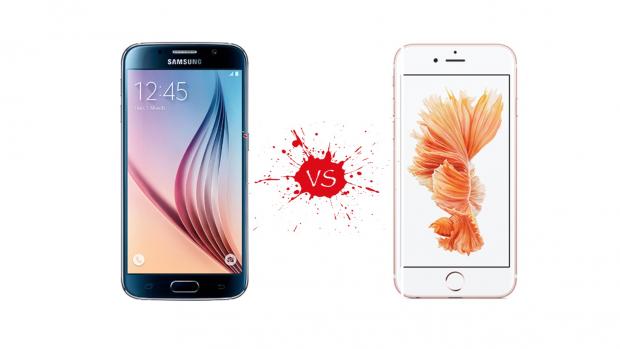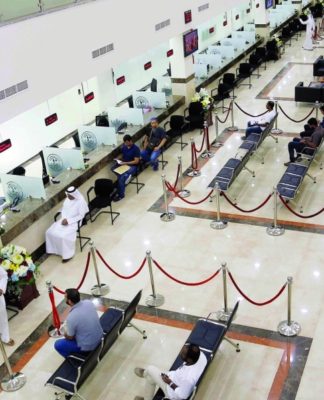This is the main fight everyone is interested in – how do the latest Samsung and Apple flagships compare?
As Apple’s handsets get launched in September, they are, in effect, the company’s flagships for the following year, as people buying the new models will be using them for at least the following 12 months. This means they end up fighting on two fronts, with the rival flagships launched inside the same year, and every launch in the subsequent run-up to the following September, from round about February onwards. Conversely, Samsung is one of those OEMs who seems to like an early year launch – its new flagships arrive at MWC in February (together with LG’s).
True to the leaks and rumours, Apple’s 2016 handset is a more reserved affair because apparently Cupertino is saving all the best stuff for 2017’s model. Yes, if the rumours continue to be true, what we’re looking at in September next year is a complete ground-up rebuild and revamp of the iPhone brand. Whether it’s called the iPhone 7s, the iPhone 8, or something more outlandish for the 10-year anniversary of the brand (iPhone X maybe?), this is allegedly the iPhone Jony Ive always wanted to build.
Reportedly it’ll be made mostly out of either glass or transparent Zirconia ceramic, possibly with a metal frame (though perhaps not – there are conflicting rumours on the subject). There are at present three variants rumoured, with the top-tier editon being the first iPhone with an OLED display panel. This new screen may take up significantly more of the fascia and could even be wrap-around or edge-to-edge affair, according to some sources. The Touch ID fingerprint scanner and Home key will remain but will apparently be hidden under the expanded display panel, and may use either ultrasonic or optical sensor tech to function.
Apple’s 2016 model iPhone 7 was officially unveiled after what seemed like an eternity of leaks, rumours, and speculation, the new model is here at last. So what’s it like? Well as per usual, the rumours were pretty much spot on.
However, there is still just about enough that Apple has tweaked aboard the iPhone 7 that may be of interest to fans – a significantly more sophisticated camera, enhanced audio features, and, for the first time ever; waterproofing!
If you want a Samsung phone in 2016 the only real option now that the Galaxy Note 7 is essentially unsafe to use is the Galaxy S7. The entire Galaxy Note 7 debacle was unexpected, as was new, replacement units continuing to explode, as one did on a South Western flight in October.
Still, the Galaxy S7 is a fantastic phone. It can take the strain placed on it by the Galaxy Note 7 dropping out of contention. Also, Apple’s iPhone 7 range can hardly be described as 100% appealing; those with iPhone 6/iPhone 6s models will likely not update and, instead, wait for next year’s models.
Of course, Apple’s biggest rival is Samsung, and it’s true that the Galaxy S7 has remained the best flagship for pretty much the whole of 2016. Does the iPhone 7 best Samsung’s hero phone? Or can the Galaxy S7 maintain its lead? Let’s have a look at how the two stack up.
Samsung Galaxy S7 vs iPhone 7: Major Specs
Samsung Galaxy S7
- Display: 5.1in Super AMOLED 2560×1440 pixels (QHD), 577ppi (Galaxy S7 edge: 5.5in, 534ppi)
- Storage: 32GB/64GB onboard , microSD slot
- CPU and RAM: Qualcomm Snapdragon 820/Samsung Exynos 8890 processor (region dependent), 4GB RAM
- Front Camera: 5MP
- Rear Camera: 12.2MP, f/1.7 aperture, 1.4um pixels, dual-pixel 100% phase detection sensor
- IP68 water and dust proofing (1.5m submersion up to 30 minutes)
- Battery: 3,000mAh (Galaxy S7 edge: 3,600mAh) NON-removable
iPhone 7
- Display: 4.7-inch and 5.5-inch 3D Touch, 1334×750 and 1920×1080 pixel resolutions, wide colour gamut
- Storage: 32GB, 128GB, and 256GB
- CPU and RAM: A10 Fusion processor, 3GB RAM
- Front Camera: 7MP with wide angle lens
- Rear Camera: Dual-lens 12MP – telephoto and wide-angle (for the Plus model), 4K video recording, optical image stabilization, /1.8 aperture, new 6-element lens, new image signal processor, quad-LED flash with flicker sensor
- NO headphone jack, Lightning port, Stereo speakers
- IP67 water and dust proofing
- Capacitive Home key with Haptic engine
Samsung muddied the waters somewhat at launch by taking a leaf out of Apple’s playbook and not disclosing much information about the processor hardware. We already knew from earlier rumours that both the Qualcomm Snapdragon 820 and Samsung Exynos 8890 SoC’s would be inside various iterations of each Galaxy S7 model, and we knew 4GB of RAM was rumoured too. However, all Samsung said on launch day is that the Galaxy S7 has a 30% CPU performance uplift over the previous generation, and a 64% speed enhancement to the GPU, along with the introduction of a liquid-cooled heatpipe and heatsink setup to help in high-performance situations.
With the passage of time, of course, we now have a clearer picture. For the European, UK, and North American markets we know we’re looking at Samsung’s Exynos chipset; although it’s pretty much a moot point as the two SoCs are more or less comparable.
Apple’s iPhone 7 uses the new A10 Fusion chipset with a boosted 3GB of RAM – the most inside any iPhone to date. The firm is promising one fifth of the battery consumption for around a 40% increase in power over the previous generation A9 chip.
On the storage side of things, Samsung hasn’t exactly pushed the boat out with only 32GB and 64GB options, though each does support microSD card expansion. Apple’s re-jigged its storage variety with a 32GB base model, skipping 64GB entirely and going straight to 128GB and 256GB higher tiers. As usual though, there’s no microSD support at all.
As far as the battery is concerned, Samsung’s gone for a sizeable 3000mAh in the Galaxy S7 and 3600mAh in the Galaxy S7 EDGE – both should provide plenty of juice on a single charge, and we found in our review testing that you will indeed get a lot of mileage out of the Galaxy S7 series. Apple hasn’t revealed much about its battery tech, other than to state that you will get an hour or two more out of your daily charge than the iPhone 6s series.
Samsung Galaxy S7 vs iPhone 7: Design & Display
The Galaxy S7 and Galaxy S7 EDGE design hasn’t changed a great deal from the Galaxy S6 series, but then, why should it? The existing design language is bloody marvelous with a pleasing shape fashioned from metal and glass. Samsung did reintroduce water and dust proofing for the Galaxy S7 series, however, making it even better than its predecessor. On the display side of things, Samsung remains the undisputed king of smartphone screens with its universally acclaimed Super AMOLED tech. The current crop of devices offer a fantastic range of features, including an excellent colour gamut, superb contrast and brightness, and some of the sharpest visuals you’ll find on a mobile to date.
The iPhone 7 design isn’t massively different from the iPhone 6s either; the antenna bands have been moved to a more discrete location, and the physical Home key has been swapped for a capacitive Haptic touch one. However, the BIG change here is that this is the first iPhone generation with water an dust proofing – at last an iPhone where a dunk in the bath isn’t a death sentence. Apple’s iPhone 7 series re-uses the same size and resolution IPS LCD Retina displays we’ve seen before, which are decent quality. But it has also upgraded the brightness levels by 25% and dropped in a super wide colour gamut for more pop.
Samsung Galaxy S7 vs iPhone 7: Camera
Samsung’s camera tech is pretty impressive and capable, while also being extremely easy to use and get good results for even the most inexperienced and non-camera-savvy users. It features a 12MP sensor with an f/1.7 aperture size, an optical image stabilisation (OIS) module, dual-LED two-tone flash, and Samsung’s amazing dual-pixel phase detection autofocus.
It remains to be seen how well Apple’s camera tech performs, but this is where the most advanced changes on the iPhone 7 series have taken place. The standard iPhone 7 model features a 12MP sensor with an f/1.8 aperture, OIS, an updated 6-element lens, a quad-LED TrueTone LED flash with flicker sensor (for capture in artificial lighting), and a new image signal processor. For the larger iPhone 7 Plus model things get even more involved as it has two 12MP sensors in a dual-sensor setup; one sensor has a telephoto lens and the other a wide-angle lens; combining all the image data for a much more detailed image as standard, but also allowing for a x2 optical zoom and 10x software zoom, and Bokeh depth-of-field effects.
Fancy picking yourself up a bargain? Check out how much the Galaxy S6 EDGE is over at Amazon!



























